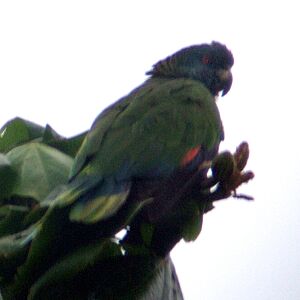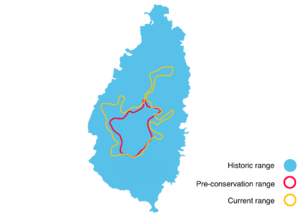Saint Lucia amazon facts for kids
Quick facts for kids Saint Lucia amazon |
|
|---|---|
 |
|
| On St Lucia | |
| Conservation status | |
| Scientific classification | |
| Genus: |
Amazona
|
| Species: |
versicolor
|
 |
|
| Synonyms | |
|
|
The Saint Lucia amazon is a special kind of parrot. It's also called the St. Lucia amazon or St. Lucia parrot. This beautiful bird lives only on the island of Saint Lucia in the Lesser Antilles. It's so important that it's the national bird of Saint Lucia! Sadly, it is considered a Vulnerable species, meaning it needs our help to survive.
Contents
About the Saint Lucia Amazon
The Saint Lucia amazon is a unique bird. It is the only type of Saint Lucia amazon, meaning there are no different subspecies. It is closely related to the red-necked amazon, which lives on the nearby island of Dominica.
What Does the Saint Lucia Amazon Look Like?
These parrots are about 42 to 46 centimeters (16.5 to 18 inches) long. They weigh between 505 and 1000 grams (about 1.1 to 2.2 pounds). Both male and female parrots look very similar.
Their forehead is a bright royal blue color. This blue becomes a bit lighter on the top of their head and face. The back of their head, neck, and shoulders are a scaly green. The rest of their upper body is plain green.
Their chest is a vibrant red. Their lower chest and belly have a mix of green and maroon colors. The area near their tail is greenish-yellow. Their wings are green with a bright red patch, and their main flight feathers are dark blue. Their tail feathers are green with wide yellowish tips.
Where Do Saint Lucia Amazons Live?
The Saint Lucia amazon lives in the mountains of Saint Lucia's inner areas. They prefer tropical, moist mountain forests. You can find them at heights between 500 and 900 meters (about 1,640 to 2,950 feet) above sea level.
Saint Lucia Amazon Behavior
How Do They Move?
Scientists don't know much about how Saint Lucia amazons move around. They don't seem to have a specific pattern of migration.
What Do They Eat?
The Saint Lucia amazon enjoys eating seeds and fruits. They get their food from many different types of palm trees and other plants found in their forest home.
Reproduction and Life Cycle
The breeding season for the Saint Lucia amazon starts around February and March. It might continue for longer than that. These parrots build their nests inside hollows or cavities in trees. A female parrot usually lays two eggs.
In zoos, where these birds are cared for, the eggs hatch after about 28 days. The young birds, called fledglings, are ready to leave the nest about 81 days after they hatch.
Saint Lucia Amazons in Zoos
From 1975 to 2021, the Jersey Zoo in Europe had a special group of Saint Lucia amazons. They worked hard to help these birds have babies. In 1982, they were the first to successfully breed this species in a zoo! Some of the baby parrots born at the zoo were later released back into the wild in Saint Lucia.
On May 2, 2021, Jersey Zoo announced that their last Saint Lucia amazon had passed away. This marked the end of their work with this species. However, a few other zoos in Europe still care for these amazing birds.
Protecting the Saint Lucia Amazon
The IUCN (International Union for Conservation of Nature) first listed the Saint Lucia amazon as "Threatened" in 1988. Since 1994, it has been listed as "Vulnerable." This means it's still at risk, but its numbers are slowly getting better.
Experts believe there are now between 1,150 and 1,500 adult Saint Lucia amazons. This is a good sign, as their population seems to be growing! In the 1950s, there were about 1,000 of these parrots. But by the late 1970s, their numbers dropped to only about 150. This was because their homes were being destroyed, people hunted them for food, and some were captured for the pet trade. Hurricanes also caused problems.
Because the parrots were in so much trouble, people in Saint Lucia started strong conservation efforts. These efforts had a lot of support from the country's people. By 1990, the population had grown to about 300 birds, and it has continued to increase since then. This shows that when people work together, they can help protect amazing animals like the Saint Lucia amazon!


